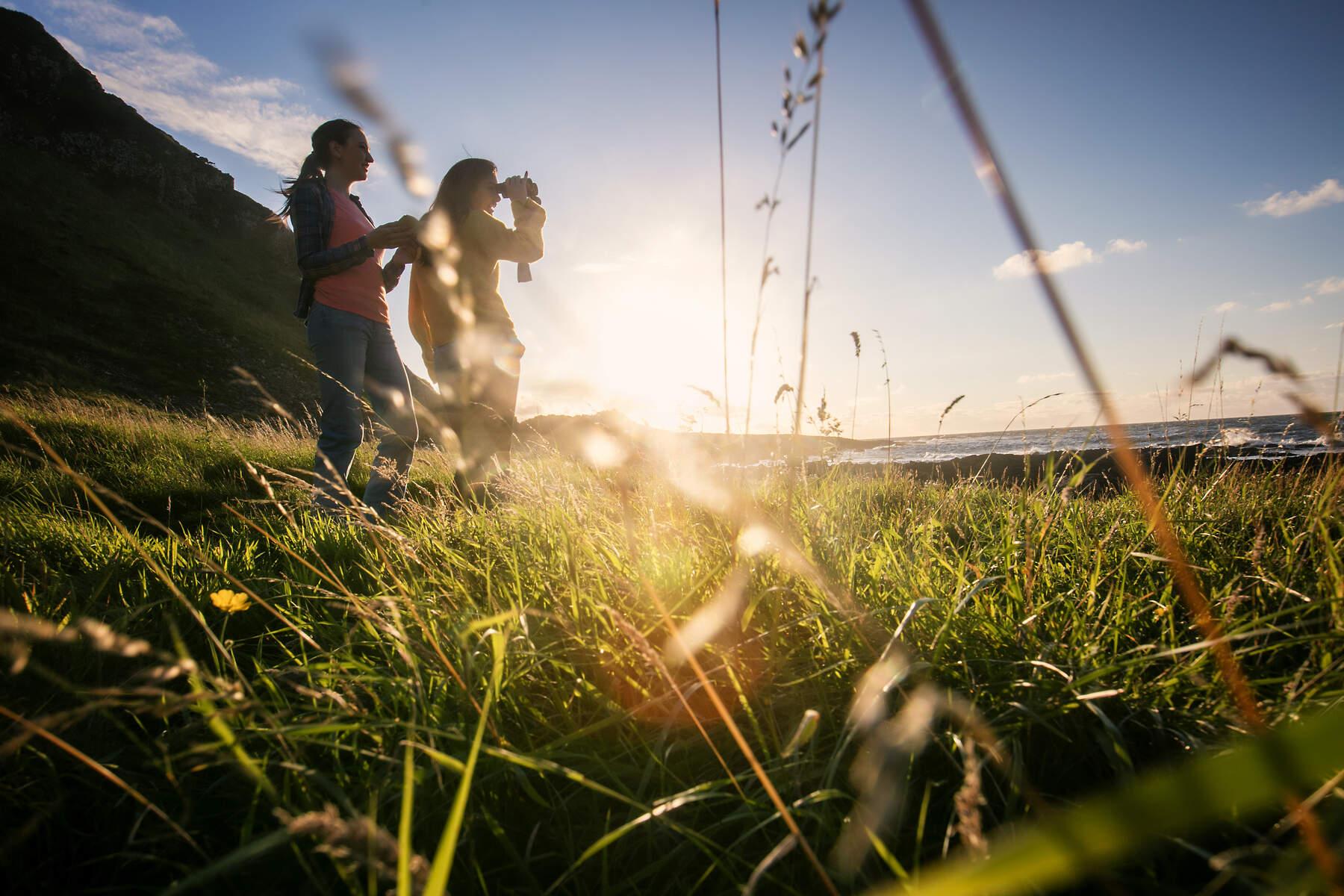
Churches of the Causeway Coast
Explore a giant spirit as you journey along Northern Ireland’s breathtaking Causeway Coast, where ancient churches stand side by side rugged castles as timeless witnesses to history and architecture.
The Causeway Coast is a place where land and legend entwine, where the wild Atlantic waves carve a rugged beauty into Northern Ireland’s northernmost shores. Here, along windswept cliffs and quiet glens, faith has stood steadfast for centuries. From ancient monastic ruins to grand Gothic revival churches, each sacred space tells a story of devotion, resilience, and breathtaking landscapes.
This is a land where giants once walked - at least, so the legends say. The hexagonal stones of the Giant’s Causeway, Northern Ireland’s only UNESCO World Heritage Site, rise like stepping stones into the sea, echoing ancient myths of Finn McCool. Just inland, the landscapes that doubled as the Seven Kingdoms in Game of Thrones create an atmosphere both dramatic and otherworldly. The churches along this route stand like sentinels of history, their walls soaked in the stories of saints, sailors, and storytellers alike.
To travel this path is to step into a world where faith and folklore intertwine, where the crashing waves of the Atlantic seem to whisper the prayers of those who have passed before. Each church is more than a place of worship - it is a sacred waypoint on a journey through time. Along this route, you will encounter the echoes of early Christian monks who brought light to the dark ages, the steadfast devotion of medieval pilgrims, and the quiet strength of communities who have kept these places alive for centuries.
The beauty of this pilgrimage lies not only in the spiritual depth of these churches but also in the breathtaking scenery that accompanies every step. From the rugged cliffs that tumble into the sea to the rolling green pastures and sheltered glens, this journey offers a profound connection to both nature and the divine. Whether you seek solace, inspiration, or a deeper understanding of Northern Ireland’s sacred heritage, this path calls to all who yearn for something beyond the everyday.
From the ancient fortress town of Carrickfergus to the wild, sea-lashed cliffs of Ballintoy, the path between these sacred places is as stirring as the churches themselves. Along the way, you will trace the footsteps of saints and seafarers, knights and pilgrims, each leaving their mark on the spiritual and physical landscape of Northern Ireland.
Explore seven gorgeous sacred spaces, in some of the most awe inspiring landscapes in the world.
This trail is one of six new trails across Northern Ireland created as part of our Treasure Ireland project, supported by The National Lottery Heritage Fund, which helps to keep places of worship in Northern Ireland open and in good repair.
Find more churches, chapels and meeting houses to visit across Northern Ireland
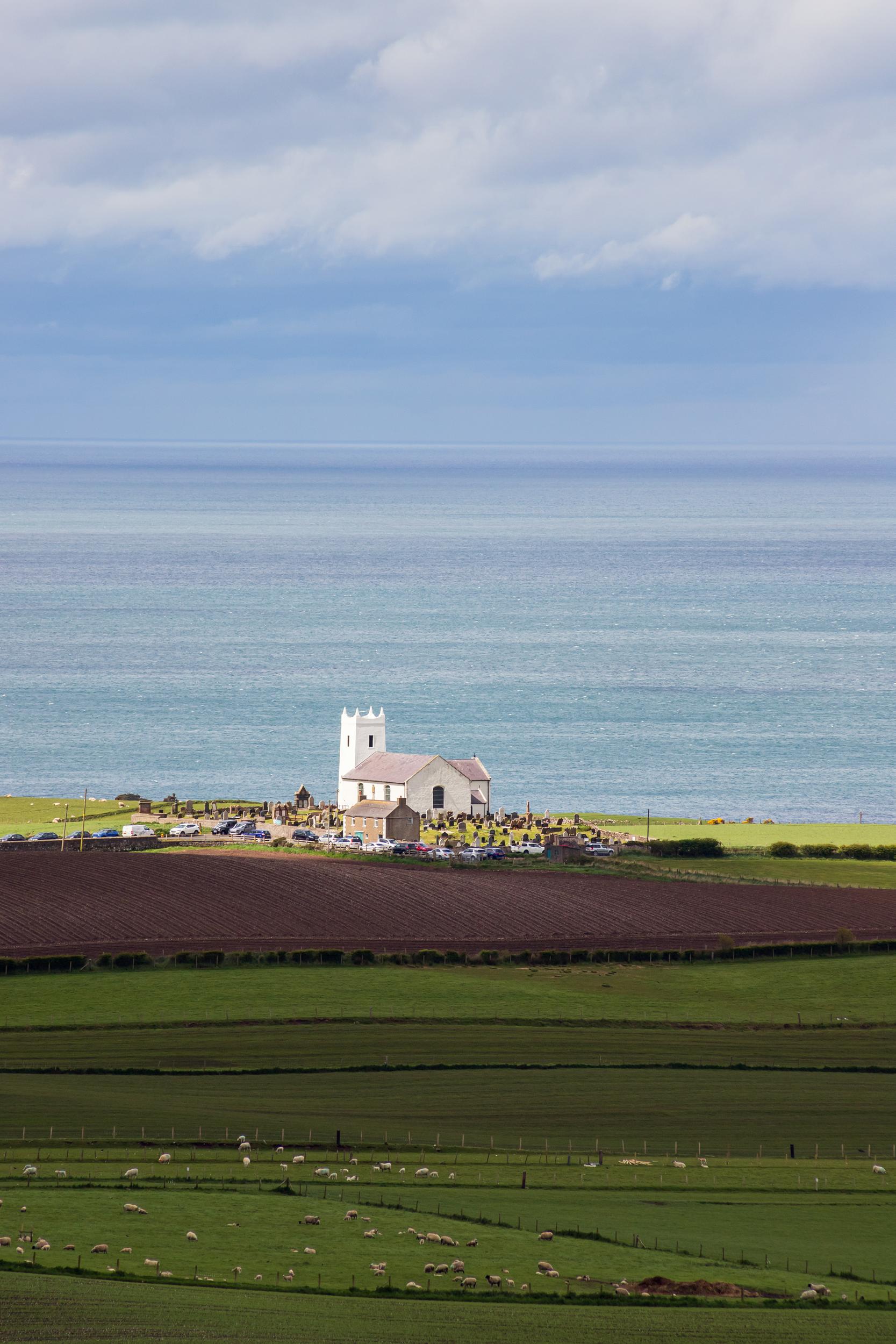
LauraMcIlveen
Your pilgrimage begins in Carrickfergus, where faith and fortification are entwined.
St Nicholas's church is a rare survivor from pre-Reformation times, was built by the legendary John de Courcy in the 12th century. Faith and fortification are entwinned as de Courcy was also responsible for the much-famed Carrickfergus Castle. Artistry, archaeology, and history have shaped this church through the ages, and it is a place where there are tangible traces of history.
The Chichester Monument, a masterpiece of Jacobean funerary craftsmanship commissioned by Sir Arthur Chichester who was instrumental in the development of Belfast city. Among the church's treasures lies a rare Flemish 16th century window and Irish stained glass from the renowned An Tur Gloinne Studio, Dublin.
This ancient town, guarded by the imposing Carrickfergus Castle, has witnessed centuries of sieges, shipwrecks, and shifting tides of history. As you explore, you may notice the ghostly imprints on the sturdy stone walls, remnants of architectural details from bygone eras. Step inside the church, and let the weight of time settle around you as sunlight filters through stained glass, casting rich hues onto the stone floors. This is a place where stories linger in the air, waiting to be heard.
The Chichester Monument, a masterpiece of Jacobean funerary craftsmanship commissioned by Sir Arthur Chichester who was instrumental in the development of Belfast city. Among the church's treasures lies a rare Flemish 16th century window and Irish stained glass from the renowned An Tur Gloinne Studio, Dublin.
Leaving Carrickfergus behind, the road hugs the coast, offering glimpses of distant Scotland on clear days. The journey northward leads you through landscapes where the land meets the sea in a clash of wild beauty - crashing waves, misty headlands, and the occasional lonely ruin standing sentinel against time.
Find out more about the St Nicholas, Carrickfergus here
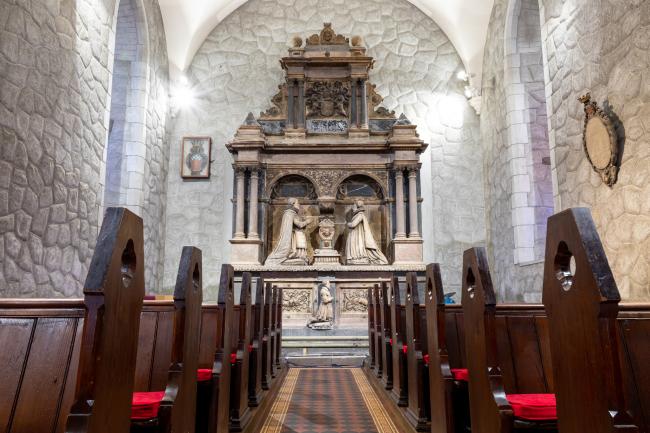
Larne, the gateway to the Glens of Antrim, is your next stop.
St Cedma’s welcomes you with a graceful 19th century lych gate, a portal between past and present. The church’s medieval origins whisper from its walls, as does it's continuing service to its community. The artistry of Irish stained glass masters like Wilhelmina Geddes (1887-1955) brings light and colour to the sacred space. Her two windows in the nave were executed during her tenure at the An Tur Gloine Studio in Dublin, and depict St Patrick and St Columba. The breathtaking blend of exquisite blues and fiery reds within these windows is truly a sight to behold and reflects the genius of Geddes.
Embedded within the wall lies a medieval stone sculpture, its motifs mirrored in intricate stained glass crafted by David Esler. Outside, a memento mori headstone, adorned with symbols of mortality, and reminding all who pass of life’s fleeting nature - a quiet moment of reflection before continuing your journey north.
The road from Larne to Glenarm is a masterpiece in itself. Known as the Antrim Coast Road, it curves along cliffs that plunge into the sea, past hidden coves and the occasional wandering sheep. The rhythm of the waves becomes a companion, their eternal ebb and flow mirroring the pulse of time.

©TourismIreland&StefanSchnebelt
Sweep around the bay into outstanding beauty, and it's not just us that say that!
The twisting road brings you into the Antim Coast & Glens Area of Outsianding Natural Beauty.
Nestled at the foot of the Glens in the village of Glenarm lies a castle steeped in history, at the heart of one of the oldest estates, Glenarm Castle is the ancestral home of the Earl of Antrim.
Adjacent to this castle, and at one end of Glenarm Viduct, stands St Patrick, set within the site of a Franciscan friary established in 1465. Recognised as the earliest example of ecclesiastical Gothic architecture Ireland, the church has evolved steadily since its construction in 1763. It replaced a pre-1683 church which originally stood on the south side of Castle Street, built through funds donated by the McDonnell noble family, originally of Dunluce Castle and later of Glenarm Castle.
As you round the bay, the road delivers you to Carnlough, where St John the Evangelist stands with its gaze fixed on the sea. The church echoes the curves of the coast in its unique octagonal design, which fosters a sense of unity within its spacious interior. Inside, magnificent contemporary stained glass windows, meticulously crafted by Lua Breen, shimmer like the water beyond, a testament to the ongoing story of faith in these lands. In the side chapel is a touch of historical significance where windows from the older church have been preserved from the Earley Studio in Dublin.
The seamless integration of contemporary and historical elements creates a captivating and harmonious ambiance within the church, making it a truly unique and spiritually enriching space.
From here, the road follows the contours of the coastline, where basalt cliffs plunge into the deep and seabirds wheel overhead. You are entering the heart of the Glens now, a place where folklore and faith intertwine, and where saints once walked barefoot on pilgrim trails.
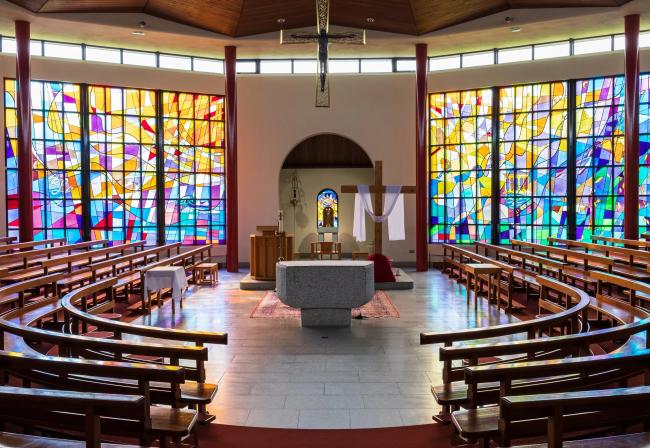
Queen of the glens, land of sparkling water
Glenariff is a place of rare and mystical beauty. The church of St Patrick & St Brigid stands as a beacon of faith against the stunning backdrop of Glenariff Bay. It's a striking free-standing gable fronted Catholic church, constructed around 1917. Here, the land and sea seem to converse in hushed tones, a reminder that this place has long been considered sacred. The Ardclinis Crozier, a relic of medieval devotion, is housed here, a symbol of the deep-rooted spirituality of the Glens.
The chancel of the church boasts three magnificent stained glass windows, masterfully crafted by Michael Healy (1873-1941) of Dublin. Adding to its charm, the church bell, forged at the esteemed Matthew Byrne Foundry in Dublin, resonates with historical significance.
In the porch of the church is a replica of the Ardclinis Crozier, a significant relic traditionally housed in the ruins of the Old Church of Ardclinis nearby along the coast. This ornate crook, crafted from bronze and silver, holds historical importance as it was traditionally thought to be used to solemnly swear upon regarding matters of truth. A tangible link to the regions rich ecclesiastical heritage it offers a glimpse into the Glens of Antrim storied past.
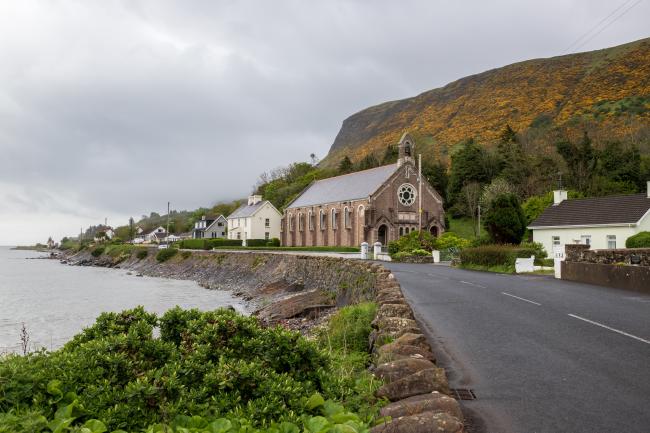
Your journey northward follows a road that winds between sea and sky, past cliffs and waterfalls, each turn offering a new vista to take the breath away.
In the heart of Cushendall, where the River Dall meets the sea, St Mary’s stands as a sanctuary among the rolling hills. The town itself is rich in folklore, and its past is deeply tied to the traditions of the Glens. Dr Delargy, a renowned folklorist, hailed from the Cushendall.
Opened in 1913, St Mary’s backs onto the serene River Dall. Replacing an earlier church it is crafted from sandstone in a Romanesque style, and features a distinctive bell tower. Inside the church, Johnny Murphy's depiction of the Baptism of Christ in stained glass tells is full of colour and light, a quiet reminder that faith is a living, breathing thing.
Outside the town, you might call in to the ruined Layd Old Church. As the road continues, you sense a shift in the landscape - the coastline becomes wilder, the cliffs more dramatic. This is the approach to the North Antrim coast, where the land begins to feel truly ancient, shaped by forces far beyond human time.
Ballycastle is a town of traders and fishermen, a place where the land meets the sea in a dance of history and commerce.
Holy Trinity, built in 1756, stands in quiet grandeur at the heart of it all. Within, light filters through the exquisite stained glass of Thomas Earley, illuminating the stories of saints and sailors alike. This is a town with a deep connection to the past, and the church is its steady anchor.
Built in 1756 by Hugh Boyd as a chapel of ease and the meticulously designed church now serves as the final resting place for Boyd himself, with his crypt lying beneath its grounds.
A prime example of mid 18th century architecture, the church exudes grandeur in its neo-classical style, commanding attention from its prominent position in Ballycastle's town square and conservation area. Its significance extends beyond mere architecture, symbolising the pinnacle of Ballycastle's prosperity and the achievements of the Boyd family, who shaped the town's fortune since the early 18th century.
Within its interior exquisite stained glass by Thomas Earley (1819-1893) illuminates the chancel. The west door is adorned with Doric columns and a tympanum. Christopher Myers is attributed to its design, further adding to its architectural pedigree.
Beyond Ballycastle, the coast takes on an elemental wildness. The famed Giant’s Causeway is near, its hexagonal stones a testament to the raw power of nature and legend. You are nearing the final stretch of your pilgrimage, where land and faith stand defiantly against the might of the Atlantic.
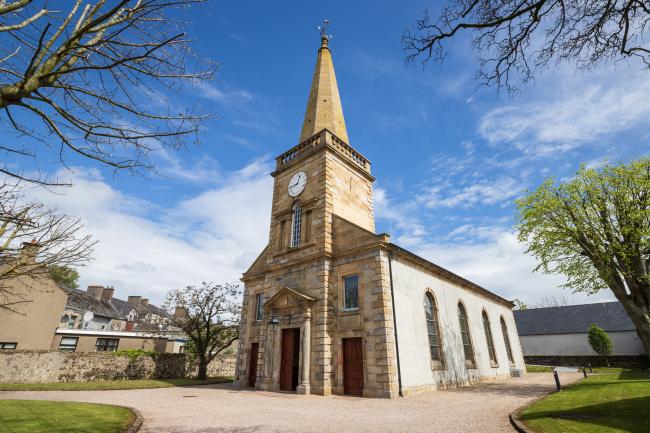
The most photographed church in Northern Ireland
Before reaching Ballintoy, make time for one of the most exhilarating stops on the Causeway Coast - Carrick-a-Rede Rope Bridge. Suspended nearly 100 feet above the crashing Atlantic, this swaying bridge has linked the mainland to a tiny island for over 250 years. Feel the sea wind whip around you as you take those first tentative steps onto the rope and wooden planks, a reminder of the untamed power of this coastline.
Then, with your heart still racing and your spirit soaring, continue your journey to Ballintoy, where the land, the legends, and the sacred converge in spectacular fashion. Perched high above Ballintoy Harbour, Ballintoy Parish Church is perhaps the most iconic church on the Causeway Coast.
Its whitewashed walls gleam against the rugged landscape, a beacon of peace and endurance. Ballintoy been a place of refuge for over 400 years - both for weary travelers and for the soul. Here, you stand at the very edge of the land, looking out across Rathlin Sound toward Scotland. The past feels close, the air thick with history, myth, and the prayers of those who came before.
With roots traced back to the 1630s, when the original church served as a chapel of ease for the Stewart family, hailing from the Isle of Bute. The tower, erected in 1733, still stands proudly today, bearing witness to centuries of history. The present church, completed in 1813, owes much of its existence to the efforts of the dynamic Revd Robert Trail, a figure of colourful character and unwavering determination.
Step into the graveyard, and absorb panoramic vistas of the North Antrim Coast, Rathlin Island, and the Scottish Isles. The influence of the Stewart family to the refuge provided by the church during the tumultuous events of the 1641 Rebellion. Inside, the stained glass window from County Cork and other architectural features that adorn this iconic church.
This breathtaking setting was chosen as a filming location for Game of Thrones, transforming Ballintoy into the rugged Iron Islands, the ancestral home of House Greyjoy. Fans of the show will recognise the harbor below as the backdrop for Theon Greyjoy’s fateful return to Pyke, where shifting tides of loyalty and destiny played out against this dramatic coastline. Inland from here are the famous Dark Hedges.
Find out more about the church here

As the waves crash below and the wind sings through the grass, you realize that this journey has been more than a tour of churches - it has been a journey through time, a pilgrimage of the heart. The sacred and the scenic are woven together here, where faith has endured against the backdrop of one of the world’s most beautiful coastlines.
Let the echoes of the past linger with you as you turn back toward home, carrying with you the stories, the sights, and the spirit of the Causeway Coast.

StefanSchnebelt
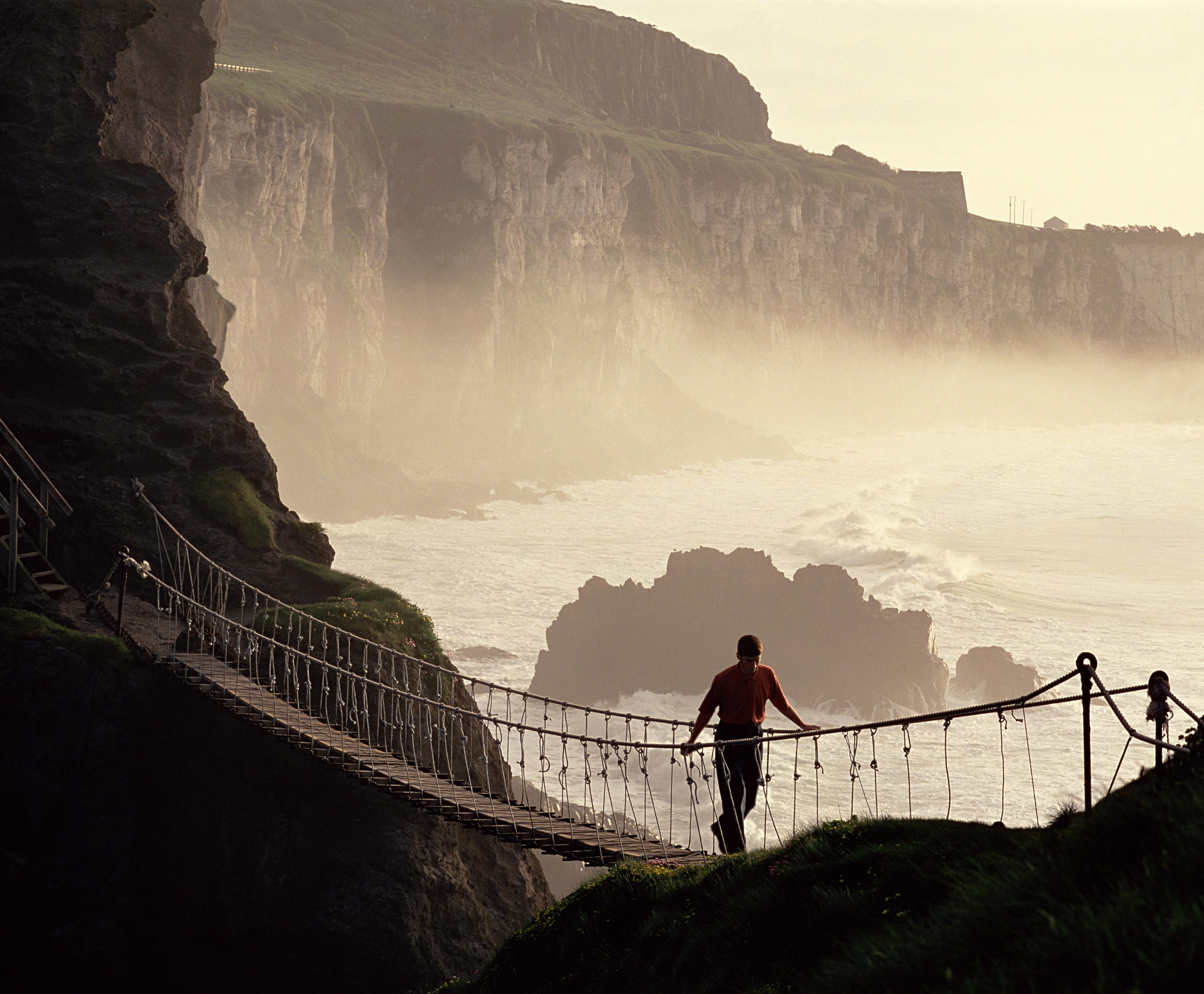
©TourismIreland&ChrisHill
